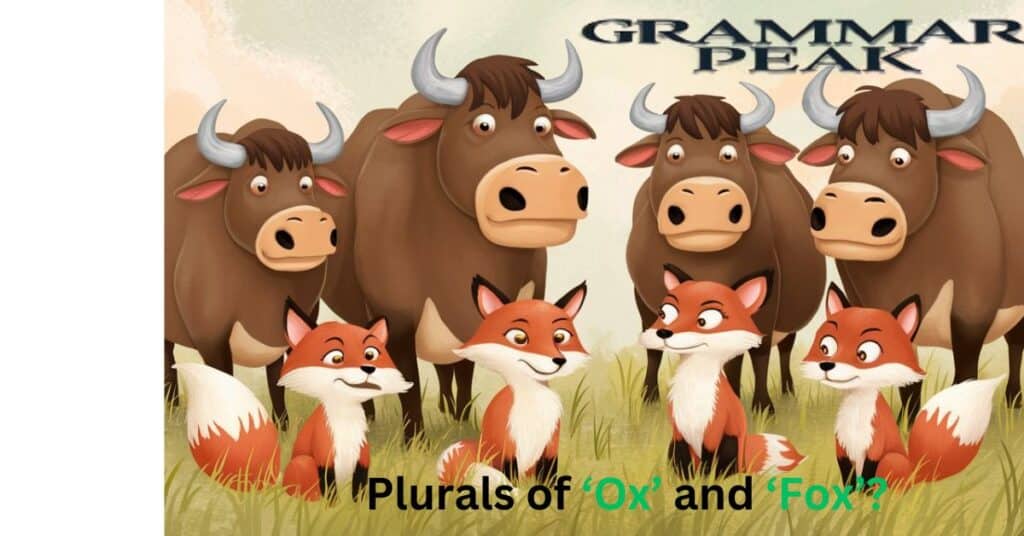English is just a rad language with all its history and strange little quirks. One of the strange quirks is the way we form words as plurals. Sometimes, adding an ‘s’ or ‘es’ just isn’t quite right. Like, have you ever wondered why we say ‘oxen’ instead of ‘oxes’? Or why ‘foxes’ instead of ‘foxen’?
Here, we’re going to explore ‘ox’ and ‘fox’ in their singular and plural variations, taking a look at the old-timey plurals and the new-school English conventions that rule them.
An ‘ox‘ refers to a member of the bovine family, usually a big, strong beast of burden. On the other hand, a ‘fox‘ is a small, cunning creature from the canine family.
Both these words have Old English roots – ‘ox‘ from ‘oxa’ and ‘fox’ from ‘fox’. These animal world names have remained fairly consistent in their singular forms over centuries.
You will might be The Plurals of ‘Ox’ and ‘Fox’?
Plural Forms: Oxen and Foxes
The plural form of ‘ox’ is ‘oxen‘, and for ‘fox’, it’s ‘foxes‘. These aren’t your typical English plurals.
Oxen
The plural form ‘oxen’ is a carryover from the Old English rules. In Old English, certain words took an ‘en’ ending to indicate their plural form.
While most of these words have faded into obscurity or have modernized their plurals, ‘oxen’ has staunchly held on to this unique pluralization.
Foxes
‘Foxes’, on the other hand, follows a more common rule of pluralization in English. Words ending in ‘s’, ‘x’, ‘z’, ‘ch’, and ‘sh’ form their plurals by adding ‘es’.
Thus, we have ‘foxes’, just as we have ‘dishes’ or ‘buzzes’. This English plural rule is more prevalent in Modern English.
Read must Be The Plurals of ‘Ox’ and ‘Fox’?
Comparing Plurals
| Singular Form | Old English Root | Plural Form | Plural Formation Rule |
| Ox | Oxa | Oxen | Old English ‘en’ ending |
| Fox | Fox | Foxes | Modern English ‘es’ ending |
Why ‘Foxes’ for ‘Fox’ and ‘Oxen’ for ‘Ox’?
The reasons behind these plural forms lie in the history of the English language. The ‘en’ in ‘oxen’ comes from Old English, where certain words used ‘en’ for plurals. Most of these words have disappeared or changed, but ‘oxen’ remains.
The ‘es’ in ‘foxes’ represents a more common modern English rule for forming plurals. These linguistic rules and their exceptions make English a fascinating language to learn and explore.
FAQ” S
Why is the plural of ‘ox’ ‘oxen’ and not ‘oxes’?
The plural ‘oxen’ is a remnant of Old English rules where some words took an ‘en’ ending for their plural form.
Why do we say ‘foxes’ and not ‘foxen’?
‘Foxes’ follows a common rule in English where words ending in ‘s’, ‘x’, ‘z’, ‘ch’, or ‘sh’ form their plurals by adding ‘es’.
Are there other words in English that form plurals like ‘oxen’?
Yes, though rare, there are other words like ‘children’ and ‘brethren’ that form their plurals with an ‘en’ ending.
Why are English plurals sometimes formed with ‘s’ or ‘es’, and other times with ‘en’?
This variation can be attributed to the history of the English language, with some plural forms carrying forward from Old English and others conforming to modern English rules.
Are ‘oxen’ and ‘foxes’ exceptions to English plural rules?
‘Oxen’ is indeed an exception to the typical English plural rules. However, ‘foxes’ conforms to a common rule where words ending in ‘s’, ‘x’, ‘z’, ‘ch’, or ‘sh’ add ‘es’ to form their plurals.
Conclusion
From ‘oxen’ to ‘foxes’, English plurals carry the weight of linguistic history. These unique English grammar rules remind us of the language’s rich past and its constant evolution. So, the next time you spot a group of oxen or a skulk of foxes, remember the quirky plurals that set them apart.

Mason Blake is an experienced blogger with a passion for language and communication. With years of expertise in crafting informative and engaging content, Mason shares valuable insights on grammar and writing. His clear, concise, and reader-friendly approach has earned him a loyal following, helping readers sharpen their language skills and master the art of effective communication.








Thank you for your sharing. I am worried that I lack creative ideas. It is your article that makes me full of hope. Thank you. But, I have a question, can you help me?
Thanks for sharing. I read many of your blog posts, cool, your blog is very good.
Your article helped me a lot, is there any more related content? Thanks!
I don’t think the title of your article matches the content lol. Just kidding, mainly because I had some doubts after reading the article.
https://t.me/s/Official_1win_kanal/1559
I don’t think the title of your article matches the content lol. Just kidding, mainly because I had some doubts after reading the article. https://www.binance.info/register?ref=P9L9FQKY
Thanks for sharing. I read many of your blog posts, cool, your blog is very good.
I don’t think the title of your article matches the content lol. Just kidding, mainly because I had some doubts after reading the article.
I don’t think the title of your article matches the content lol. Just kidding, mainly because I had some doubts after reading the article.
Your point of view caught my eye and was very interesting. Thanks. I have a question for you. https://accounts.binance.info/en/register?ref=JHQQKNKN
I don’t think the title of your article matches the content lol. Just kidding, mainly because I had some doubts after reading the article.
Can you be more specific about the content of your article? After reading it, I still have some doubts. Hope you can help me. 注册gate
Turkey sightseeing tours Turkey tours packed with surprises! Each region had distinct character and charm. Loved it all! https://terrenosenxalapa.com/?p=2474
This was a very informative post. I appreciate the time you took to write it.
Thanks for making this easy to understand even without a background in it.
Your writing always inspires me to learn more.
I hadn’t considered this angle before. It’s refreshing!
Your tips are practical and easy to apply. Thanks a lot!
I’ll be sharing this with a few friends.
You clearly know your stuff. Great job on this article.
I’ve gained a much better understanding thanks to this post.
I appreciate the depth and clarity of this post.
I love how well-organized and detailed this post is.
I agree with your point of view and found this very insightful.
Thanks for making this so reader-friendly.
Your tips are practical and easy to apply. Thanks a lot!
I hadn’t considered this angle before. It’s refreshing!
Thanks for making this easy to understand even without a background in it.
You bring a fresh voice to a well-covered topic.
This gave me a whole new perspective on something I thought I already understood. Great explanation and flow!
This was a very informative post. I appreciate the time you took to write it.
I appreciate the depth and clarity of this post.
What a helpful and well-structured post. Thanks a lot!
You always deliver high-quality information. Thanks again!
You clearly know your stuff. Great job on this article.
I really needed this today. Thank you for writing it.
This was easy to follow, even for someone new like me.
This topic really needed to be talked about. Thank you.
Thank you for covering this so thoroughly. It helped me a lot.
You’ve clearly done your research, and it shows.
I agree with your point of view and found this very insightful.
z8mxr6
9np1n3